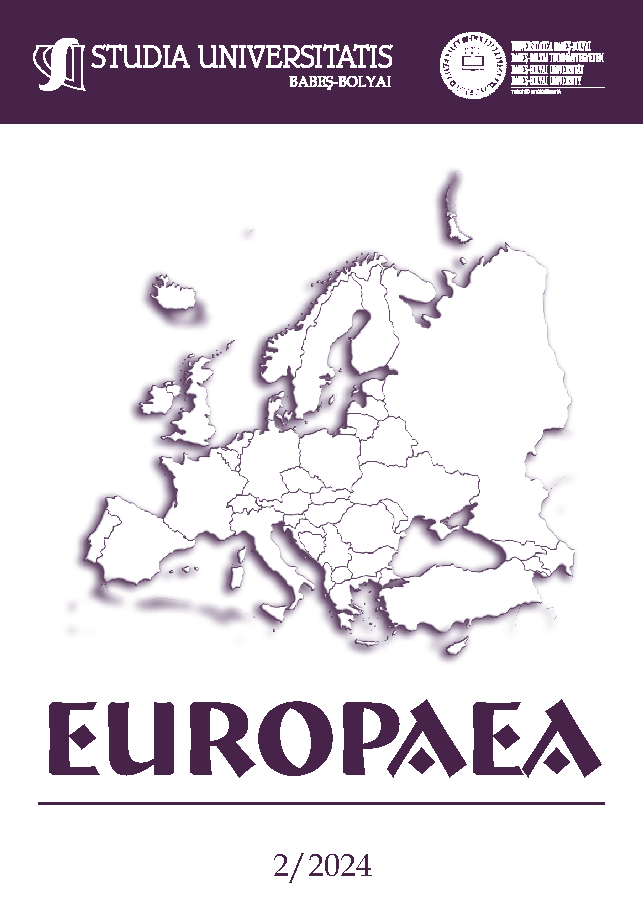TURKISH IDENTITY. ETHNIC AND CULTURAL CHARACTERISTICS AND IDENTITY FORMATION
DOI:
https://doi.org/10.24193/subbeuropaea.2024.2.13Keywords:
ethnic identity, religious identity, Türkiye, ethnogenesisAbstract
Turkish identity has two fundamental pillars: ethnic identity and cultural identity. These two pillars were formed and later consolidated on a historical route of going from the presocietal ethnic groups to the tribal organisation and then to a tricontinental empire, with an ideological Islamic identity. Türkiye followed an ascending constant in its formation, and the central element of its formation as a great power was identity – the element that gave vitality, the engine that set in motion all the other component elements.
References
1. Chebel, Malek (2005), Dicționar de simboluri musulmane, Pitești: Paralela 45.
2. Gheerbrant, Alain; Chevalier, Jean (2009), Dicționar de simboluri, Iași: Polirom.
3. Goldziher, Ignaz (1981), Introduction to Islamic Theology and Law, Princeton, New Jersey: Princeton University Press.
4. Howard, Douglas A. (2016), The History of Turkey, Second Edition, Santa Barbara, California: Greenwood.
5. Kafesoğlu, Ibrahim (2020), Türk Millî Kültürü, Istanbul: Ötüken.
6. Kinross, Lord (2019), Istoria Imperiului Otoman. Mărirea și decăderea Imperiului Turc, București: Orizonturi.
7. Mehmed, Mustafa Ali (1976), Istoria turcilor, București: Editura Științifică și Enciclopedică.
8. Rabasa, Angel; Larrabee, F. Stephen (2008), The Rise of Political Islam in Turkey, Santa Monica: RAND National Defense Research Institute.
9. Stone, Norman (2021), Scurtă istorie a Turciei, București: Litera.
10. Tezcan, Mahmut (2000), Türk Ailesi Antropolojisi, Ankara: İmge Kitabevi.
11. *** Coranul și traducerea explicativă (2015), Ankara: Departamentul pentru servicii confesionale.
12. Brice, W.C., „The Turkish Colonization of Anatolia”, Escholar Manchester, [https://www.escholar.manchester.ac.uk/api/datastream?publicationPid=uk-ac-man-scw:1m1904&datastreamId=POST-PEER-REVIEW-PUBLISHERS-DOCUMENT.PDF], accessed on 02.04.2023.
13. Çetin, Halil (2012), „Ağaç Motifli Osmanlı Saltanat Rüyasının Tabir İlmi Açısından Değerlendirilmesi” in Akademik Bakış Dergisi, Vol. 5, No. 10, [https://dergipark.org.tr/en/download/article-file/73909], accessed on 02.04.2023
14. Çetin, Halil (2012), „Osmanlı Saltanat Rüyaları ve Tarihî Bağlam”, in Tarih İncelemeleri Dergisi, Vol. XXVII, No. 1, [https://dergipark.org.tr/tr/download/article-file/58814], accessed on 02.04.2023.
15. Danış, Ihami, „İslam Coğrafyacılarından Osmanlı Coğrafyacılarına Yeryüzünün Matematiksel Taksimi: Hakiki (Yedi) İklim”, Istanbul University Press, [https://cdn.istanbul.edu.tr/file/JTA6CLJ8T5/19178D4C861E4FC08E5541A6862EA6A2], accessed on 02.04.2023.
16. Inalcık, Halil, „Kanunnâme”, Türkiye Diyanet Vakfı İslâm Ansiklopedisi, [https://islamansiklopedisi.org.tr/kanunname], accessed on 12.08.2022
17. Öztürk, Murat, „İslamiyet’ten Önce Türklerin Din Anlayışı ve Gök Tanrı Dini”, in History Studies International Journal of History, Vol. 5, No. 2, 327-346.
18. Sümer, Faruk, „Kayı”, Türkiye Diyanet Vakfı İslam Ansiklopedisi, [https://islamansiklopedisi.org.tr/kayi], accessed on 02.04.2023.
19. *** "Why Turkey is now ‘Türkiye’, and why that matters" (2021), TRT World, 13th December, News/Magazine, [https://www.trtworld.com/magazine/why-turkey-is-now-turkiye-and-why-that-matters-52602], accessed on 05.11.2022.
Downloads
Published
How to Cite
Issue
Section
License
Copyright (c) 2024 Studia Universitatis Babeș-Bolyai Studia Europaea

This work is licensed under a Creative Commons Attribution-NonCommercial-NoDerivatives 4.0 International License.



